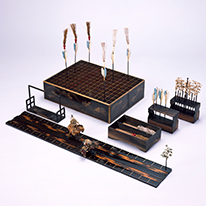Past Exhibitions
- The Aesthetic Pleasures of Incense
- January 24, 2017 - March 12, 2017
The custom of burning incense to purify spaces and calm the heart and mind was imported to Japan along with Buddhism. Among the Heian (794–1185) aristocracy, it was common practice to make personal blends from aromatic materials including plant roots and nuts, tree barks and resins, and musk, and to match these against one another in contests, present them as gifts, and use them to scent clothing.
During the Muromachi period (1392–1573), under the influence of Chinese-style Zen Buddhism, it became common to burn single pieces of incense wood, and Chinese lacquerware incense containers and celadon incense burners became highly prized. The fashion for burning a single variety of incense wood led to the later evolution of a game known as kumikō, in which people sought to discern among several types of incense. This incense game evolved during the Edo period (1615–1868) prompting the development of various specialized implements.
The fragrant woods used for incense were precious imported materials, and the utensils used for this incense were produced with a high level of skill and elegant craftsmanship. Please take your time savoring these breathtaking works, intended to be as aesthetically pleasing as the aromatic fumes of incense.












